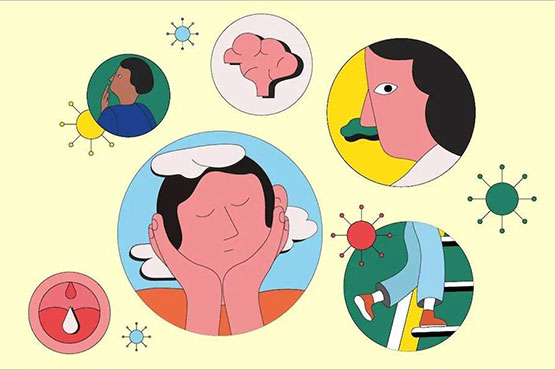Post-COVID Syndrome
The challenge for medicine will be the “long COVID tail”
/Prof. Dr. Yana Simova, Executive Director of BCI/
WHAT DOES “POST-COVID-SYNDROME” MEAN?
 Usually, the symptoms of COVID-19 resolve within 4 weeks of the onset of the disease – the so-called “acute COVID-19” phase. If the complaints continue after the fourth week (or reappear), we are now talking about so-called “long COVID-19”. The “long COVID-19” itself is divided into two periods: from the 4th to the 12th week is the “prolonged symptomatic COVID-19”, and after the 12th week we speak of the “post-COVID-19 syndrome”. It includes symptoms such as shortness of breath, easy fatigability, persistent cough, joint and muscle pain, cardiovascular complaints, impaired kidney and liver function, depression, brain fog and even hair loss. Evidence has recently emerged of recorded cases where symptoms do not resolve even 6 months after cure.
Usually, the symptoms of COVID-19 resolve within 4 weeks of the onset of the disease – the so-called “acute COVID-19” phase. If the complaints continue after the fourth week (or reappear), we are now talking about so-called “long COVID-19”. The “long COVID-19” itself is divided into two periods: from the 4th to the 12th week is the “prolonged symptomatic COVID-19”, and after the 12th week we speak of the “post-COVID-19 syndrome”. It includes symptoms such as shortness of breath, easy fatigability, persistent cough, joint and muscle pain, cardiovascular complaints, impaired kidney and liver function, depression, brain fog and even hair loss. Evidence has recently emerged of recorded cases where symptoms do not resolve even 6 months after cure.
The results so far show conclusively that the virus affects vital organs such as the brain, heart, lungs. And the Center for Disease Control and Prevention in the USA adds more psychiatric and dermatological consequences to this list. BCI’s experience shows exactly how these organs are affected – by damaging and altering their small vessels. SARS-CoV-2 can infiltrate the endothelial cells of blood vessels – those innermost, delicate cells – and damage them. In addition to being a key factor in the elasticity of the vessels, they have receptors that allow the virus to enter them. When they become damaged, they cannot perform their functions properly, the vessels become blocked and this prevents the exchange of oxygen and nutrients with the cells of the organs.
SYMPTOMS
“My fatigue is unlike anything I’ve experienced before”
 Regardless of the severity of the course of the disease, in some sufferers changes are observed up to 6 months after infection. Most often, patients complain of fatigue, shortness of breath, cough, muscle and joint pain, loss of sense of smell. Patients with a more severe course are left with an immune imbalance and increased risk for injection with other pathogens. Those who have been ill for a long period of time are incapacitated, and in addition to physical deficits – so-called chronic fatigue syndrome – they remain emotionally unstable for a long time. Residual symptomatology depends on many factors – age, presence of respiratory failure, length of hospital stay. Some authors consider acute “post-COVID syndrome” to be the presence of complaints more than three weeks after the onset of the illness, and chronic “post-COVID syndrome” to be symptomatology after more than 12 weeks.
Regardless of the severity of the course of the disease, in some sufferers changes are observed up to 6 months after infection. Most often, patients complain of fatigue, shortness of breath, cough, muscle and joint pain, loss of sense of smell. Patients with a more severe course are left with an immune imbalance and increased risk for injection with other pathogens. Those who have been ill for a long period of time are incapacitated, and in addition to physical deficits – so-called chronic fatigue syndrome – they remain emotionally unstable for a long time. Residual symptomatology depends on many factors – age, presence of respiratory failure, length of hospital stay. Some authors consider acute “post-COVID syndrome” to be the presence of complaints more than three weeks after the onset of the illness, and chronic “post-COVID syndrome” to be symptomatology after more than 12 weeks.
Increasingly, the medical community has come to believe that COVID-19 is not just a respiratory disease, but a systemic disease that requires serious surveillance. One in five sufferers has symptoms of ‘post-COVID syndrome’.
Pulmonary
Dr. Radka Alexandrova, MD, pulmonologist at Medical Center European Cardiology – Sofia. With extensive experience in the treatment of asthma, COPD and follow-up of patients who have undergone COVID-19:
“Post-COVID syndrome” is the result of structural and functional changes in various organs and systems. The lung – the target organ of the virus – is affected by severe alveolitis, endothelial vascular damage with microthromboembolism, secondary bacterial infection. At the third month of the disease, radiological changes – focal fibrosis and interstitial seals – were still observed. For their accurate diagnosis it is necessary to perform a CT scan of the lung. Other important indicators for follow-up of this syndrome is performing a functional respiratory study, if necessary a diffusing capacity study, and plethysmography.
Cardiology
Prof. Dr. Yana Simova is Executive Director and Member of the Board of Directors of BKI, Head of the Cardiology Department at Heart and Brain Hospital Pleven. Head of the Post-COVID Syndrome Research Group and Principal Investigator and Medical Director of the National Diagnostic and Treatment Campaign “Life after COVID“
“When a COVID infection strikes the lungs, the heart is forced to work at higher speeds to make up for the lack of oxygen in the blood. This causes the heart muscle to become overworked – especially dangerous in people with cardiovascular disease, diabetes and hypertension. Pulmonary damage is a serious prerequisite for cardiac post-COVID sequelae.
The most common cardiac complaints are associated with rhythm and conduction disturbances; destabilization of arterial pressure follows; dysmetabolic changes that patients do not suspect – probably the result of corticosteroid therapy or severe infectious syndrome in general. There is a series of changes in laboratory parameters, starting with lipid profile and blood glucose and going up to elevated D-dimer and ferritin, which often persist for a very long time.
Asymptomatic findings (‘signals’ that patients do not feel) are also diagnosed with disturbing frequency. For example, a disturbance in the deformation (internal shortening and work) of the heart muscle.”
Neurological
Prof. Dr. Plamen Bozhinov, MD, PhD, Head of the Clinic of Neurology at the Heart and Brain Hospital Pleven, member of the Board of Directors of the BKI, member of the Union of Scientists in Bulgaria, Bulgarian Society of Neurology, Vice-Chairman of the Bulgarian Society against Epilepsy
“At the very beginning of the pandemic, the involvement of neurologists seemed unnecessary. The virus was thought to lead to severe respiratory disease, often affecting the cardiovascular system, largely sparing the brain and other parts of the nervous system. However, this view was quickly changed by a number of studies of hospitalised patients, many of whom had a variety of neurological manifestations, including changes in mental status and acute cerebrovascular accidents. Although there are more neurological questions than answers in this setting, the incidence of neurological complications has become a reason to focus efforts on understanding the mechanisms responsible for nervous system involvement. In addition, many patients with chronic neurological diseases are considered at risk for coronavirus infection; therefore, their monitoring and treatment must be adapted to the current situation.
Symptomatology can be both on the central nervous system side (headache, dizziness, cerebrovascular disease, impaired consciousness, transverse myelitis, encephalopathy and encephalitis, epilepsy, ataxia) and on the peripheral nervous system side (hypogeusia, hypoosmia, neuralgia, Guillan-Barre syndrome, myopathy). Nerve tissue damage is most likely induced by two main mechanisms – hypoxic encephalopathy and immune-mediated nervous system damage.
COVID-19 and stroke: the exact incidence and risk factors for ischemic stroke in COVID-infected patients remain poorly understood. Mechanisms are multiple, with the main driver highlighting the virus-mediated cytokine storm and coagulation disorders evidenced by elevated D-dimer and platelet values, as well as the accompanying cardiac complications that lead to subsequent embolic events. Paradoxically to the expected complications associated with the virus, a decrease in the incidence of strokes has been reported worldwide.
COVID-19 and multiple sclerosis: The occurrence of COVID-infection in patients with diagotic multiple sclerosis, whether or not they are on treatment, is theoretically risky. On the other hand, multiple sclerosis is not a disease that weakens the immune system.
One of the most severe possible complications is Guillain-Barre Syndrome, which is a progressive paralysis over hours or days, beginning with numbness and weakness in the feet and lower limbs and an inability to move and walk. The disease has a slowly or rapidly progressive course, creeping upward and involving the entire musculature, including the respiratory and facial muscles. If timely measures are not taken, breathing stops and the patient, though fully conscious, cannot live without the aid of a breathing apparatus.
Fortunately, most nervous system complications are not severe or fatal. Many patients experience severe anxiety, complain of balance disturbances, tinnitus, headaches or memory impairment. For now, however, it is believed that there is no direct link between the severity of COVID infection and the risk of neurological complications. However, it should be remembered that Post-COVID-syndrome can hide surprises for months after the illness and each case should be treated individually.
Psychological
Aneta Mischeva, PhD in Psychology at the Hospital of Psychology Veliko Tarnovo:
“The direct and indirect psychological and social effects of the COVID-19 pandemic are already widespread. They are expected to affect the mental health now and in the future of groups of people, with or without mental illness. It is possible that the increase in anxiety symptoms may be as an adaptive response to stress, as mental illnesses on the spectrum of anxiety disorders and depression, and as damaging behaviours (alcohol and substance misuse, gambling and suicide) . Loneliness and isolation in general have been shown to be strongly associated with anxiety, depression and self-injurious behaviour throughout an individual’s lifetime and are accepted as risk factors for mental health during and after quarantine.
A recent study published in the Lancet Psychiatry found that the risk of anxiety disorders increases after COVID-19. Strong scientific evidence is presented that 1 in 5 patients diagnosed with COVID-19 within the first three months is diagnosed with a mental disorder such as anxiety, depression or insomnia. Individuals recovering from COVID-19 were twice as likely to become ill with a mental disorder compared to those with influenza. In addition, hospitalized COVID-19 patients were found to be more likely to be diagnosed with a psychiatric disorder. They tend to experience anxiety, fear, sadness, and a distressing sense of isolation for a long time. Some survivors report sleep problems and/or distressing dreams in which they painfully experience that they cannot breathe, that they are returning to the ICU, and that they are going to die. COVID-19 sufferers also have fears for their loved ones that they too will become ill or that they may die. Younger patients are more likely to show frustration that their recovery is slow and prolonged. Their lack of previous experience of serious illness makes illness and recovery stressful and distressing to experience.
Cognitive changes are not rare after a COVID-19 bout, with memory and attention impairments such as forgetfulness and difficulty concentrating to perform a particular activity. “
LIFE AFTER COVID – BKI CAMPAIGN
 In September 2020, BCI launched “Life after COVID”, a free, open-ended screening campaign for patients who have survived COVID infection, unprecedented in Bulgaria. BCI’s multidisciplinary teams continue to collect and process the information obtained from each screening, and the results have sparked the interest of reputable scientific publications.
In September 2020, BCI launched “Life after COVID”, a free, open-ended screening campaign for patients who have survived COVID infection, unprecedented in Bulgaria. BCI’s multidisciplinary teams continue to collect and process the information obtained from each screening, and the results have sparked the interest of reputable scientific publications.
BCI expresses readiness for public-private partnership to benefit COVID-19 patients
WHO believes long COVID may be due to persistence of virus in the body







